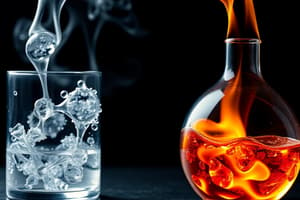Podcast
Questions and Answers
What happens during energy transfer?
What happens during energy transfer?
- Molecules change color
- Heat moves from one object to another (correct)
- Objects change shape
- Friction causes sound waves
How does friction between two surfaces affect them?
How does friction between two surfaces affect them?
- It creates resistance (correct)
- It makes them colder
- It changes their weight
- It makes them move faster
What do researchers discover through scientific exploration?
What do researchers discover through scientific exploration?
- Fictional stories
- Ancient ruins
- Artificial intelligence
- New facts about the universe (correct)
In what way does heat transfer affect molecules within materials?
In what way does heat transfer affect molecules within materials?
What is the main purpose of conducting experiments in science?
What is the main purpose of conducting experiments in science?
What is the goal of science?
What is the goal of science?
How is matter identified in terms of mass and weight?
How is matter identified in terms of mass and weight?
What determines whether an object is considered hotter or colder compared to another object?
What determines whether an object is considered hotter or colder compared to another object?
What term describes when two pieces of matter can influence each other directly?
What term describes when two pieces of matter can influence each other directly?
Why do scientists study matter?
Why do scientists study matter?
Which measurement indicates the amount of substance of matter?
Which measurement indicates the amount of substance of matter?
Flashcards are hidden until you start studying
Study Notes
Science is the pursuit of understanding how things work through observation and experiment, with the goal of formulating theories based on evidence. One important aspect of science is studying matter — the elements found all around us in various forms. This includes everything from solid objects like rocks and furniture, to fluids such as water and oil, to gases like air and steam.
Matter has unique properties which scientists study. For instance, we know that matter takes up space because it occupies volume; this means if you were able to collect all the atoms in your body together into one place, they would take up some amount of room. Additionally, matter can be identified by its mass, the amount of substance of something, and weight, the force exerted by gravity between two masses. Scientists also understand that different types of matter have varying amounts of energy, often measured in joules; the total quantity of energy in an object will determine whether it's considered hotter or colder compared to another thing made out of other kinds of stuff.
Understanding what makes up our world begins with learning about how things interact with each other. When two pieces of matter come close enough to influence each other directly without needing anything else separating them, this is called direct contact. During these interactions, energy transfers can occur. Energy transfer happens when heat moves from one piece of stuff to another, changing both their temperatures so they match more closely over time. This process causes molecules within materials move faster or slower depending on where they started off - meaning their temperature changes! Another type of interaction might involve friction, where two surfaces rub against each other creating resistance.
Science helps people explore new ways of understanding reality using experiments designed specifically to answer questions about specific aspects of nature—like those related to matter. By exploring both everyday items and exotic phenomena alike, researchers discover new facts about the universe every day. So next time you look at the chair under your desk or feel cold wind whipping past during winter walks outside, remember there's always more going on beneath the surface thanks to scientific exploration!
Studying That Suits You
Use AI to generate personalized quizzes and flashcards to suit your learning preferences.




